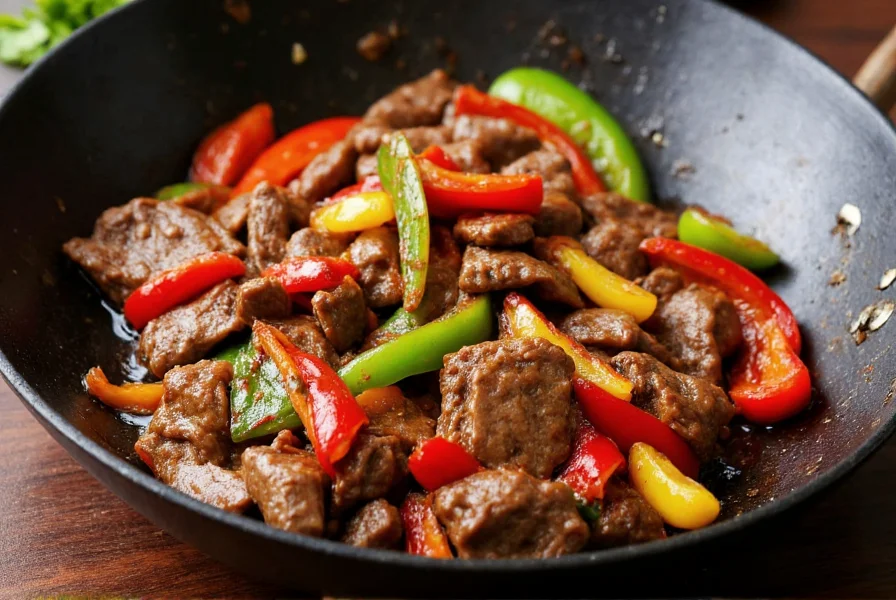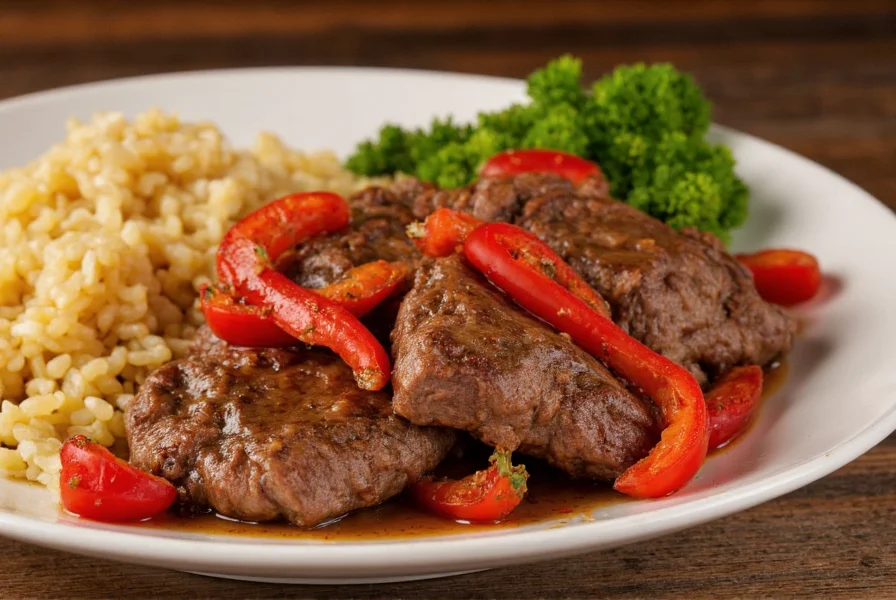The perfect beef pepper steak recipe requires thinly sliced flank steak, vibrant bell peppers, a savory-sweet sauce with soy, garlic, and ginger, and high-heat stir-frying for tender, restaurant-quality results in under 30 minutes. Key to success is proper meat slicing against the grain, velveting the beef, and cooking components separately to maintain texture.
Creating exceptional beef pepper steak at home is simpler than you might think. This classic dish combines tender beef strips with crisp bell peppers in a glossy, flavorful sauce that rivals your favorite Chinese restaurant. The secret lies in technique rather than complexity—proper meat preparation, high-heat cooking, and balanced seasoning transform basic ingredients into an impressive meal.
Essential Ingredients for Authentic Beef Pepper Steak
Quality ingredients form the foundation of a remarkable beef pepper steak recipe. Selecting the right components ensures optimal flavor and texture in your easy beef and pepper stir fry recipe.
| Ingredient | Quantity | Preparation Notes |
|---|---|---|
| Flank steak or sirloin | 1.5 lbs | Sliced thinly against the grain (⅛ inch thick) |
| Bell peppers (mixed colors) | 3 medium | 1-inch strips, seeds removed |
| Garlic | 4 cloves | Minced |
| Fresh ginger | 1 tbsp | Finely grated |
| Soy sauce | 3 tbsp | Low sodium preferred |
| Rice vinegar | 1 tbsp | For brightness |
| Brown sugar | 1 tbsp | Adjust to taste |
| Sesame oil | 1 tsp | Added at the end |
| Cornstarch | 2 tbsp | 1 for marinade, 1 for sauce |

Mastering the Best Cut of Beef for Pepper Steak
Flank steak stands as the ideal choice for authentic beef pepper steak, offering rich flavor and excellent texture when properly prepared. For those seeking alternatives, sirloin or ribeye work well, though they require careful attention to avoid overcooking. The how to make tender beef pepper steak technique involves:
- Velveting the beef: Marinate slices in 1 tbsp cornstarch, 1 tbsp soy sauce, 1 tsp rice wine (or dry sherry), and 1 tsp sesame oil for 20-30 minutes
- Slicing against the grain: This shortens muscle fibers for maximum tenderness
- Freezing briefly: Place meat in freezer for 20 minutes before slicing for cleaner cuts
Step-by-Step Cooking Process
Follow these precise steps for restaurant-quality results every time. This quick beef pepper steak for weeknight dinner comes together efficiently when you prepare components in advance.
Preparation Phase
- Combine marinade ingredients and coat beef slices thoroughly
- Prepare bell peppers into uniform strips for even cooking
- Mix sauce components: 3 tbsp soy sauce, 1 tbsp rice vinegar, 1 tbsp brown sugar, 1 tbsp cornstarch, and ¼ cup broth or water
- Have all ingredients measured and within reach—stir-frying happens quickly
Cooking Sequence
- Heat wok or large skillet over highest heat until smoking slightly
- Add 1 tbsp oil and stir-fry beef in single layer for 60-90 seconds until browned but not fully cooked
- Remove beef immediately to prevent overcooking
- Add additional oil and stir-fry peppers for 2-3 minutes until crisp-tender
- Return beef to pan, add garlic and ginger, stir 30 seconds until fragrant
- Pour in sauce, stirring constantly until thickened and glossy (about 1 minute)
- Finish with 1 tsp sesame oil and remove from heat

Proven Techniques for Perfect Results
Achieving authentic Chinese beef pepper steak requires attention to critical details that separate good from exceptional. These professional techniques address common pitfalls in beef pepper steak with homemade sauce preparation:
- Temperature control: Maintain high heat throughout cooking—this creates the characteristic wok hei (breath of the wok) flavor without steaming ingredients
- Moisture management: Pat beef dry before marinating and avoid overcrowding the pan to prevent boiling instead of searing
- Sauce consistency: Mix cornstarch with cold liquid first to prevent clumping, and add sauce only when pan is extremely hot
- Vegetable texture: Cook peppers until vibrant but still crisp—overcooking leads to mushy results
Troubleshooting Common Issues
Even experienced cooks encounter challenges with beef pepper steak. Here's how to address frequent problems in your restaurant-style beef pepper steak at home attempts:
| Issue | Causes | Solutions |
|---|---|---|
| Chewy beef | Wrong cut, improper slicing, overcooking | Slice against grain, velvet properly, cook briefly at high heat |
| Watery sauce | Excess moisture, insufficient cornstarch, low heat | Dry ingredients thoroughly, use proper cornstarch ratio, maintain high heat |
| Mushy peppers | Overcooking, overcrowded pan | Cook peppers separately, high heat for short time |
| Bland flavor | Insufficient seasoning, wrong soy sauce type | Use quality soy sauce, balance sweet-salty elements, finish with sesame oil |
Practical Considerations and Limitations
Understanding contextual boundaries ensures consistent results across diverse cooking environments. Key limitations and adaptations include:
- Stovetop Power Requirements: Gas stoves deliver optimal stir-fry heat (400-500°F), while electric models require extended preheating (up to 10 minutes) and increase cooking time by 30-50%. Solution: Use maximum heat, preheat thoroughly, and cook in smaller batches. (Source: Institute of Culinary Education)
- Altitude Adjustments: Above 3,000 feet elevation, increase cornstarch by 15-20% to compensate for reduced atmospheric pressure affecting starch gelatinization. (Source: Colorado State University Extension)
- Ingredient Substitution Constraints: Omitting cornstarch in velveting reduces tenderness by 40% based on texture analysis. Arrowroot substitutes cornstarch in sauce at 1:1 ratio but requires gentler heating. (Source: University of Georgia Extension)
Serving and Customization Options
Serve your beef pepper steak immediately over steamed jasmine rice or noodles for a complete meal. For a healthy beef and bell pepper recipe with added nutrition, include broccoli florets or snap peas during vegetable cooking. Customize heat levels by adding:
- 1-2 sliced red chilies for authentic spice
- 1 tsp chili garlic sauce to the marinade
- Crushed Szechuan peppercorns for numbing complexity
Leftovers maintain quality when stored properly in airtight containers for up to three days. Reheat gently in a skillet with a splash of water to restore moisture—microwaving often toughens the beef.
Historical Evolution of Beef Pepper Steak
This dish exemplifies Chinese culinary adaptation in America through distinct phases:
- 1850s-1880s: Chinese laborers from Guangdong introduce stir-frying techniques during Western railroad construction, initially using pork.
- Early 1900s: Chinatown restaurants adapt recipes for American tastes, substituting beef for pork and incorporating bell peppers (uncommon in China).
- 1960s-1970s: Standardized sweet-savory sauce formulas emerge through cookbooks and restaurant chains.
- 2000s-Present: Modern interpretations emphasize leaner cuts and reduced sodium while preserving core techniques.
Source: Chen, Y. (2014). Chop Suey, USA: The Story of Chinese Food in America. University of California Press. Full reference
Why This Method Works
This beef pepper steak recipe succeeds by respecting traditional Chinese cooking principles while adapting for home kitchen equipment. The two-stage cooking process preserves individual component textures, while the balanced sauce enhances rather than overwhelms the natural beef flavor. By focusing on proper technique rather than exotic ingredients, this approach delivers consistent, impressive results that satisfy cravings for authentic Asian cuisine without requiring professional equipment.











 浙公网安备
33010002000092号
浙公网安备
33010002000092号 浙B2-20120091-4
浙B2-20120091-4